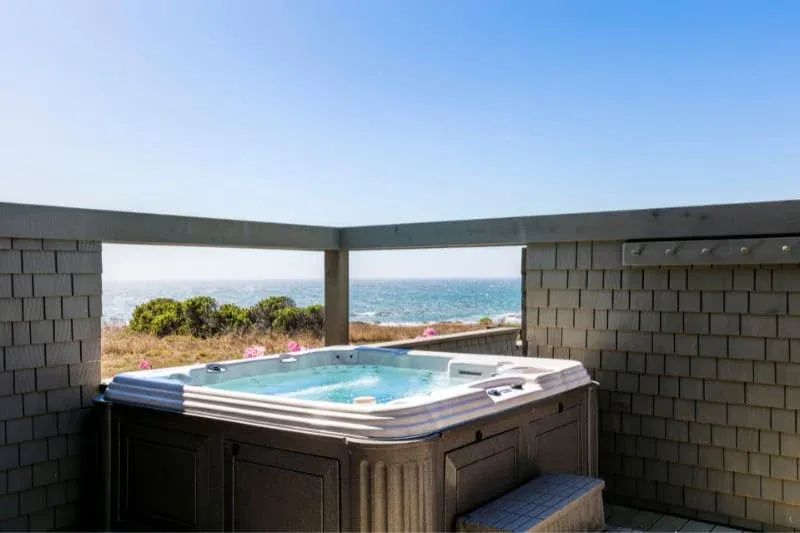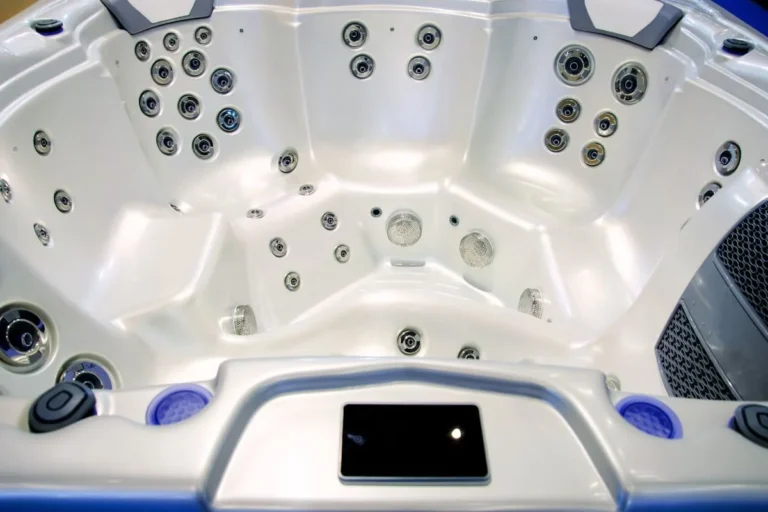How to Lower Alkalinity in Hot Tub: Easy Steps (2025)

If you’ve noticed cloudy water, chalky buildup around your jets, or skin irritation after soaking, you’re likely dealing with high alkalinity. This common problem can damage your hot tub and make soaking unpleasant.
Key Takeaways
- How to lower alkalinity in hot tub: Use white vinegar (½ cup per 100 gallons), sodium bisulfate (3 oz per 1,000 gallons), or advanced aeration technique
- Fastest method: Sodium bisulfate reduces alkalinity by 10 ppm in 24 hours
- Cheapest method: White vinegar costs $3-5 vs $15-25 for commercial chemicals
- When to act: Alkalinity above 120 ppm needs immediate treatment per CDC standards
- Safety requirement: Always wear gloves and eye protection when handling acids
- Important rule: Lower alkalinity first, then adjust pH – never do both at once
I’ve maintained hot tubs for over a decade, and high alkalinity doesn’t just ruin your relaxation time – it can cost thousands in equipment repairs.
But here’s the good news: lowering alkalinity is simple when you know the right methods. This guide shows you three proven techniques to lower alkalinity in hot tubs used by professionals, with exact dosages and safety steps.
Table of Contents
What Causes High Alkalinity in Hot Tubs
High alkalinity builds up over time from several sources.
1. Body products cause alkalinity spikes. Lotions, sunscreen, perfumes, and hair gel contain alkaline compounds. When you soak without showering first, these products dissolve into your water and raise alkalinity levels.
2. Your body adds alkaline substances, too. Sweat, body oils, and dead skin cells go into the water during soaking. The Arkansas Department of Health guidelines mention how “contaminants such as sweat, oils, and lotions” impact water chemistry.
3. Chemical mistakes also cause problems. Adding too much baking soda or an alkalinity increaser pushes levels too high. Mixing chemicals incorrectly or using heavy doses creates similar issues.
4. Your water source might be the problem. Some areas have naturally high alkalinity in their tap water. Not changing your spa water every 3-4 months or maintaining proper cleaning routines lets these compounds build up over time.
How to Test Alkalinity Properly
Good testing gives you accurate results. The CDC Model Aquatic Health Code recommends testing the alkalinity weekly.
- Take water from elbow depth using a clean container. This avoids surface dirt that can mess up your reading.
- Pick your testing method.
- Test strips are easy but less accurate.
- Liquid test kits work better.
- Taylor Technologies uses a method where you “add 2 drops of reagent 7, 5 drops of reagent 8, then reagent 9 dropwise until color changes from green to red.”
- Test at room temperature. Hot water affects the chemicals in test kits. Let your sample cool down first.
The right alkalinity range is 80-120 ppm according to state health departments. Numbers above 120 ppm need fixing right away.
How to Lower Alkalinity in Hot Tub
You have three proven methods to reduce alkalinity levels safely and effectively. Each approach works differently, so pick the one that fits your situation, budget, and comfort level.
The key is choosing the right method based on how high your alkalinity is and what supplies you have available. All three methods work, but they differ in cost, speed, and complexity.
👉 Method 1: White Vinegar (Budget-Friendly Option)
White vinegar provides the most economical approach to alkalinity reduction. This household acid safely lowers both alkalinity and pH without requiring specialized chemicals or protective equipment.
Use the precise dosage: ½ cup per 100 gallons of water. This ratio, established through extensive field testing, provides predictable results without overshooting your target range. For a typical 350-gallon hot tub, you’ll need approximately 1.75 cups of distilled white vinegar.
Follow the 24-hour protocol religiously. Add the vinegar while jets are running to ensure proper distribution, then wait a full 24 hours before retesting. This waiting period allows the acid to fully react with alkaline compounds and reach chemical equilibrium.
Cost comparison reveals significant savings. White vinegar costs $3-5 per gallon and treats 4-6 minor alkalinity adjustments, making it the most budget-friendly option available. Commercial alkalinity reducers cost $15-25 per container for similar results.
Limitations include slower action and mild effectiveness compared to commercial products. Vinegar works best for minor alkalinity adjustments (10-20 ppm reduction) rather than major corrections.
👉 Method 2: Sodium Bisulfate (Most Reliable)
Sodium bisulfate, commonly sold as “pH decreaser,” represents the gold standard for alkalinity reduction in professional hot tub maintenance.
Master the dosage calculations: 3 ounces per 1,000 gallons reduces alkalinity by 10 ppm. For more significant reductions, research shows that “42 pounds sodium bisulfate is required for a 1 ppm alkalinity drop in a 20,000 gallon pool”, which scales down to precise measurements for hot tubs.
- Apply using the broadcasting technique while the jets run continuously. Sprinkle the granules evenly across the water surface rather than dumping them in one spot. This method ensures rapid dissolution and prevents localized chemical concentration that can damage surfaces.
- Wait a minimum of one hour for circulation, then retest after 24 hours for accurate readings. The Association of Pool & Spa Professionals standards recommend this timing for chemical equilibrium.
Safety considerations are important. Sodium bisulfate “causes severe skin burns and eye damage,” according to Safety Data Sheets, requiring proper protective equipment during handling.

👉 Method 3: Advanced Acid + Aeration Technique
This professional method combines precise acid dosing with strategic aeration to lower alkalinity while maintaining pH stability. Industry experts developed this technique for situations requiring significant alkalinity reduction without pH crashes.
You can use either sodium bisulfate (dry acid) or muriatic acid (liquid acid) for this method. Sodium bisulfate is the same chemical as Method 2 and is safer for beginners. Muriatic acid works faster but requires extra safety precautions.
- Start with continuous aeration by turning on all jets and air features. Keep them running throughout the entire process. Aeration raises pH naturally while leaving alkalinity unchanged, creating the perfect conditions for acid addition.
- Calculate your total acid needs based on current and target alkalinity levels. Research indicates that “8 oz dry acid = 100 ppm reduction in 350 gal tub” provides the baseline calculation for dosing requirements. For muriatic acid, use about 1 oz per 350 gallons for the same reduction.
- Add half the remaining acid needed (not more than 1 cup, not less than 1 tablespoon per addition). This tapering approach prevents pH crashes while steadily reducing alkalinity. Professional operators use this method because “the higher your TA, the less effect acid will have on your pH.”
- Monitor pH levels continuously. Keep pH above 7.6 throughout the process. If pH drops below this threshold, continue aeration without adding more acid until pH recovers to 7.8 or higher.
- Use 30-minute aeration cycles between acid additions. This timing allows the acid to react fully with alkaline compounds while aeration naturally raises pH back to acceptable levels.
- Taper acid amounts as you approach target levels. Start with larger doses when alkalinity is very high, then reduce quantities as you near your 80-120 ppm goal.
Safety Rules for Chemical Use
Chemical safety protects you and your hot tub. OSHA standards require proper safety steps when using chemicals.
- Wear the right gear. Use rubber gloves, eye protection, and proper clothes. Make sure you have good air flow when working with acids.
- Never mix chemicals. Add one chemical at a time. Wait 15 minutes between different chemicals. Keep your cover off while adding chemicals.
- Always add acid to water, never water to acid. This rule prevents dangerous reactions that can splash and hurt you.
- Know what to do if accidents happen. Have fresh water ready to rinse skin or eyes if chemicals touch you.
Balancing pH After Alkalinity Reduction
Lowering alkalinity typically drops pH levels due to the chemical relationship between these parameters. The Taylor Technologies guidelines explain this connection: “alkalinity is determined by titration with a standard acid,” which naturally affects pH.
- Use sodium carbonate (soda ash) to raise pH without significantly affecting alkalinity. This chemical specifically targets pH adjustment while leaving your newly corrected alkalinity levels stable.
- Test in the proper sequence: always adjust alkalinity first, then pH. This order prevents the frustrating cycle of chasing chemistry, where adjusting one parameter throws off the other.
- Allow 24-48 hours for water chemistry stabilization after making adjustments. Water chemistry takes time to reach equilibrium, and patience prevents overcorrection that creates new problems.
Cost Comparison and Prevention
Chemical cost comparison reveals significant differences between methods:
- Muriatic acid: $8-12 per gallon (enough for 10+ treatments in a 350-gallon hot tub)
- Sodium bisulfate: $15-25 per container (handles 8-12 alkalinity reductions)
- White vinegar: $3-5 per gallon (good for 4-6 minor adjustments)
Preventing problems costs less than fixing them:
- Make everyone shower before getting in. This removes body products that raise alkalinity.
- Change your water every 3-4 months and maintain clean filters to prevent buildup. Learn how to clean a hot tub filter for better water circulation.
- Test weekly to catch problems early. Small fixes cost much less than big repairs or service calls.
Troubleshooting Stubborn Alkalinity Issues
1. When alkalinity keeps bouncing back up, check your source water alkalinity levels. Some regions have naturally high alkalinity that requires pre-treatment or more frequent adjustments. Multiple state guidelines recognize this regional variation.
2. If alkalinity won’t respond to treatment, test Total Dissolved Solids (TDS). When TDS exceeds 1,500 ppm, water becomes “saturated” and resists chemical adjustments. You need to drain and refill your hot tub. Here’s how to drain a hot tub safely and completely.
3. For emergency alkalinity reduction with readings above 200 ppm, use the advanced aeration technique with professional-grade sodium bisulfate. Never attempt to correct severe alkalinity spikes with single large chemical additions.
Professional vs. DIY Decision Framework
Handle alkalinity issues yourself when readings fall between 120-160 ppm and you have proper testing equipment and chemicals. Most homeowners can safely manage minor alkalinity adjustments with proper guidance.
Call a professional service for readings above 180 ppm, suspected equipment damage, or repeated failed correction attempts. Professional water analysis can identify underlying issues that standard home tests miss.
Consider professional service annually for comprehensive water analysis and equipment inspection. This preventive approach catches problems before they become costly repairs.
Conclusion
Mastering hot tub alkalinity management protects both your investment and your enjoyment.
Start with proper water testing today, choose the method that fits your situation and comfort level, and take that first step toward professional-quality water management.
These proven methods, backed by industry standards and professional experience, give you the tools needed for crystal-clear, perfectly balanced water.

“Become a Sauna Expert Overnight!”
Grab Your “FREE” Sauna E-book NOW!
Get your hands on the ultimate sauna manual. From history to DIY setups, our free guide has it all.

As a Chartered Accountant turned sauna enthusiast, I bring a unique blend of analytical skills and hands-on experience to the world of heat therapy. With over a decade dedicated to researching and testing sauna products and practices, I’ve developed a deep understanding of this field. A the founder of HomeInDepth.com, I provide reliable, easy-to-understand information on all aspects of saunas. My goal is to guide you through every step of your sauna journey, offering meticulously researched, unbiased advice to help you make informed decisions and create your perfect sauna experience. I’m always happy to hear from sauna lovers like you—feel free to leave questions or share your own tips in the comments below so we can learn together. Contact me on:







One Comment